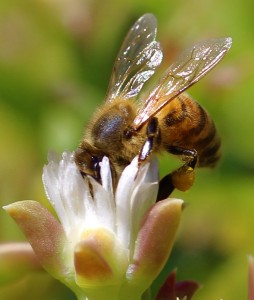26
Aug
Country-wide Field Study Links Pollinator Decline to Pesticide Use
(Beyond Pesticides, August 26, 2015) A study performed by the Food and Environment Research Agency (FERA) in the United Kingdom (UK) provides evidence of confirming the link between neonicotinoid pesticides and continually increasing honey bee colony losses on a landscape level. The study, Evidence for pollinator cost and farming benefits of neonicotinoid seed coatings on oilseed rape, was published in the Nature journal Scientific Reports. This is a significant study, as the UK government has always maintained that neonicotinoid pesticides do not threaten bees, and that honey bee losses are instead caused by the parasitic varroa mite, siding with industry arguments that pesticides are safe when used properly. However, this new study indicates otherwise, confirming a direct link between neonicotinoids and h oney bee colony losses at a nationwide level.
oney bee colony losses at a nationwide level.
This study distinguishes itself from a previous study in the U.S. that extrapolated real world neonicotinoid exposure levels to test hives by analyzing actual fields in a long-term assessment. To a large degree, the new study addresses industry critics of the earlier study design who have tried to discount previous findings of bee decline associated with neonicotinoid use (see Beyond Pesticides’ Sowing the Seeds of Doubt, which addresses these industry myths). In the wake of the new findings, the authors call for more large-scale field-based research to determine the impact of the use of a newer generation of neonicotinoids on pollinators.
Neonicotinoids have been found by a growing body of scientific literature to be linked to honey bee and pollinator decline. In 2013, the European Commission voted to suspend the use of neonicotinoid pesticides for two years after the European Food Safety Authority (EFSA) released a report identifying “high acute risk” to honey bees from uses of certain neonicotinoid chemicals. However, this action was opposed by the UK government. Despite this opposition, Britain was required to comply with the ban under European Union (EU) rules. This did not stop the UK from trying to find ways around the ban, with chemical industry giants like Syngenta applying for emergency applications to allow the use of neonicotinoids in order to avoid “irreparable damage” from pests. A 2014 request for an emergency application was eventually withdrawn in the face of public outcry, but just this past July the UK approved an emergency application to allow the use of neonicotinoids on oilseed rape crop, despite the continued moratorium put in place by the EU. This emergency exemption is disheartening in light of these recent findings connecting neonicotinoid use with pollinator declines, and calls into question UK government decisions, which have, in the past, been found to allow unacceptable industry influence regarding research and decisions on pesticide products.
In this new study, researchers at FERA in the UK studied pesticides as seed treatment on oilseed rape crops (known as canola in the United States) across nine different regions in Wales and England. When neonicotinoids are used as a seed treatment (or applied to the seed), the chemical, which is highly toxic and persistent, stays in the crop as it grows. The 11-year study found that mortality rates were 10 percent higher for bee colonies that had high levels of exposure to imidacloprid (a neonicotinoid) than for those with low field exposure.
Other noteworthy findings in this study include insight into the role of neonicotinoid treated seeds in agriculture. Industry proponents of coated seeds claim that applying such a coating reduces the subsequent applications of foliar insecticide sprays necessary, while at the same time increasing yields. However, the benefits of using these treated seeds, the study finds, is negligible, and may lead to further problems for pollinators down the road as the neonicotinoids used to treat seeds become incorporated into the plant as it grows. These findings are consistent with a report released by the U.S. Environmental Protection Agency (EPA) that determined soybean seeds treated with neonicotinoid insecticides provide little or no overall benefits in controlling insects or improving yield or quality in soybean production, confirming scientific findings that these chemical treatments are unnecessary and inefficacious.
The honey bee is the most important commercial pollinator, globally responsible for pollinating at least 90% of commercial crops. Given that one in every three bites of food is dependent on pollination, and that commercial beekeeping adds between $20 to $30 billion dollars in economic value to agriculture each year in the U,S., it is imperative that action is taken to protect bees and other pollinators all over the world. In the UK, honey bees are the most frequent flower visitor to oilseed rape.
The report’s authors say, “As long as acute toxins remain the basis of agricultural pest control practices, society will be forced to weigh the benefits of pesticides against their collateral damage. Nowhere is this tension more evident than in the system with the world’s most widely used insecticide, the world’s most widely used managed pollinator and Europe’s most widely grown mass flowering crop.”
Beyond Pesticides has long advocated a regulatory approach that prohibits high hazard chemical use and requires alternative assessments. Although EPA announced a moratorium on new bee- and bird- harming neonicotinoid pesticide products and uses, farm, beekeeper and environmental groups, including Beyond Pesticides, have urged EPA to also suspend the huge numbers of other bee-harming pesticides already on the market. We suggest an approach that rejects uses and exposures deemed acceptable under risk assessment calculations, and instead focuses on safer alternatives that are proven effective, such as organic agriculture, which prohibits the use of neonicotinoids. See how you can help through Bee Protective.
All unattributed positions and opinions in this piece are those of Beyond Pesticides.
Source: The Guardian










